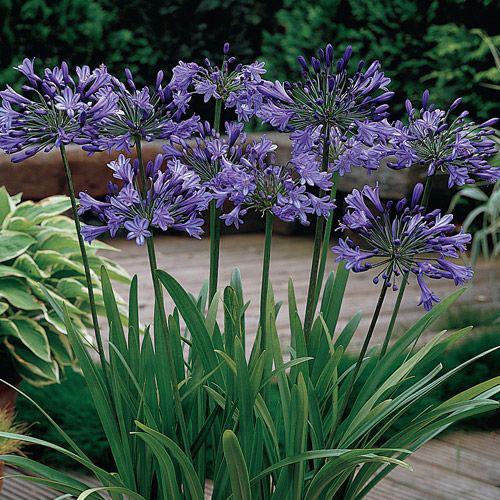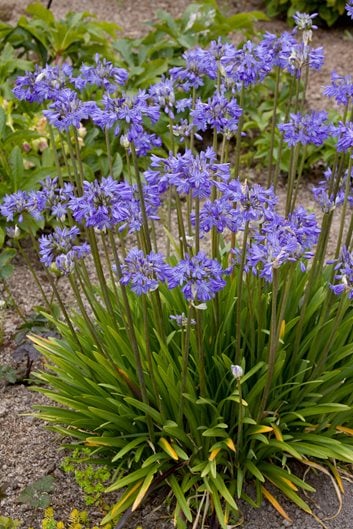Exactly how to Plant and Maintain Agapanthus in Your Garden
Exactly how to Plant and Maintain Agapanthus in Your Garden
Blog Article
Releasing the Secret to Successful Agapanthus Growing: Advice for a Flourishing Yard
In the world of horticulture, growing agapanthus efficiently needs a critical approach that incorporates different aspects of plant treatment. With mindful focus to information, one can open the tricks to nurturing these spectacular blossoms, resulting in a yard that thrives with charm and vibrancy. By comprehending the subtleties of agapanthus farming, one can develop an environment where these plants flourish and bloom generously. In the following discussion, we will explore vital tips and tricks that will direct you towards a prospering agapanthus garden, supplying understandings right into finest techniques, dirt problems, watering methods, and more.
Planting Agapanthus: Ideal Practices
When growing Agapanthus, proper dirt preparation is necessary for ensuring successful growth and growth of these stunning flowers. Agapanthus, typically called Lily of the Nile or African lily, prospers in well-draining dirt with a slightly acidic to neutral pH degree - Agapanthus. Before planting, it is vital to change heavy clay dirts with organic matter such as garden compost or peat moss to boost water drainage and supply important nutrients for the plants
To plant Agapanthus, choose a location that receives full sunlight to partial shade, as this will certainly advertise healthy and balanced development and bountiful blooming. Dig an opening two times the size of the plant's origin ball and put the Agapanthus at the same deepness it was previously expanding. Delicately backfill the opening with dirt, pushing down firmly to remove any air pockets around the origins.
Water the newly grown Agapanthus completely and continue to keep the dirt evenly damp, particularly during the plant's energetic expanding period. Agapanthus. Using a balanced plant food once a month can additionally support the plant's growth and blooming. By complying with these finest techniques for growing Agapanthus, you can produce a sensational display of these exciting flowers in your yard
Suitable Dirt Conditions for Agapanthus
For ideal growth and blooming success of Agapanthus plants, making sure the dirt problems are perfect is vital. Agapanthus flourishes in well-draining dirt with a somewhat acidic to neutral pH degree ranging from 6.0 to 7.0. This kind of dirt allows for adequate water drainage, protecting against waterlogging which can lead to root rot. To boost dirt drain, consider including raw material such as garden compost or peat moss when preparing the growing website. In addition, Agapanthus prefers dirt that is rich in nutrients, so including a well balanced fertilizer during the growing season can promote healthy development and lively blooms.

Watering and Feeding Tips
To make sure healthy growth and dynamic blooms, appropriate watering and fertilizing strategies are necessary for effective Agapanthus growing. Agapanthus plants take advantage of normal watering, specifically throughout the growing period. It is advised to water deeply once a week, making certain the soil is moist yet not soaked. Throughout heat or in pots, more regular watering might be required to avoid the soil from drying entirely.
When it involves fertilizing Agapanthus, a balanced fertilizer with equal components nitrogen, phosphorus, and potassium can be applied in the springtime to advertise healthy growth and flowering. Slow-release fertilizers are suitable for supplying nutrients slowly over an extensive duration. Prevent over-fertilizing, as this can bring about too much foliage growth at the cost of blooms.
In addition, incorporating raw material like garden compost right into the dirt can improve nutrient levels and enhance dirt framework, assisting in the overall health and wellness of the Agapanthus plants. By complying with these watering and feeding pointers, garden enthusiasts can guarantee their Agapanthus plants grow and create stunning screens of blossoms.
Trimming and Deadheading Strategies
Correct pruning and deadheading techniques play an important duty in maintaining the wellness and aesthetic appeals of Agapanthus plants, complementing the necessary techniques of watering and fertilizing for effective farming. Pruning Agapanthus involves eliminating invested blossom heads, yellowing or dead leaves, and total shaping of the plant to advertise better development. Deadheading, the process of eliminating discolored blossoms, not just enhances the plant's appearance however additionally urges additional flowering.
When deadheading Agapanthus, it is advisable to trim off the blossom stem at the base utilizing sharp, tidy shears. This process reroutes the plant's power from seed manufacturing back right into root and vegetation development, advertising a much healthier and more robust plant. Routine deadheading can prolong the flowering duration of Agapanthus and protect against self-seeding, which can bring about overcrowding.
In terms of pruning, Agapanthus typically gain from a light trim after blossoming to clean the plant and encourage fresh growth. Reducing the invested blossom stems and getting rid of any kind of damaged or dead foliage helps keep the plant's vitality and overall appearance. Nonetheless, it is important to prevent cutting right into the crown of the plant, as this can damage its wellness.

Protecting Agapanthus From Pests and Diseases
Implementing reliable bug and disease management approaches is vital to safeguarding the health and vitality of Agapanthus plants in cultivation. Agapanthus are usually sturdy plants, but they can still succumb to various parasites and illness if not properly looked after. One typical parasite that impacts Agapanthus is the Agapanthus borer, a caterpillar that passages right into the plant, triggering damage to the flowers and fallen leaves. To stop problems, routine examination of the plants is necessary. If borers are spotted, they can be manually removed, or insecticidal soap can be used as a control measure.
Along with insects, Agapanthus are at risk to diseases such as origin rot and fungal leaf places. These issues can commonly be prevented by making certain proper drain and preventing overwatering. Impacted parts of the plant must be without delay gotten rid of to stop further spread if signs of illness show up. news Fungicides may likewise be used as a treatment action, complying with the manufacturer's instructions very carefully. By remaining vigilant and attending to insect and illness concerns immediately, garden enthusiasts can help their Agapanthus flourish and grow.

Conclusion
Finally, effective growing of agapanthus calls for proper growing techniques, excellent soil problems, adequate watering and fertilizing, routine trimming and deadheading, and protection from bugs and conditions. By complying with these pointers and techniques, gardeners can ensure a growing yard full of stunning agapanthus blossoms. Agapanthus. Remember to maintain constant treatment and focus to information to promote the health and durability of these spectacular plants
When growing Agapanthus, correct soil preparation is essential for making sure successful growth and growth of these stunning blossoms.Water the recently grown Agapanthus extensively and proceed to maintain the soil evenly wet, particularly throughout the plant's active growing period.For optimal growth and flowering success of Agapanthus plants, guaranteeing the dirt problems are perfect is important. When planting or hair transplanting Agapanthus, make certain the dirt is well-prepared to provide the required foundation for the useful source plants to develop themselves efficiently. One typical pest that impacts Agapanthus is the Agapanthus borer, a caterpillar that passages into the plant, triggering damage to Learn More Here the blossoms and fallen leaves.
Report this page